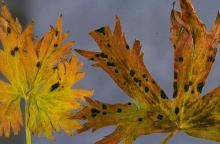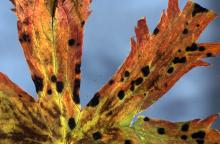Cause The bacterium Pseudomonas syringae pv. delphinii has been found on Delphinium by the OSU Plant Clinic. Another bacterium, Pseudomonas chicorii, has similar symptoms but has not been reported from the Pacific Northwest. These bacteria survive as soil inhabitants, in plant debris and in the crowns of infected plants. Contaminated soil particles can be moved by water, tools, and people. Bacteria infect aboveground plant parts. Bacterial cells that move onto the plant's surface can be spread by splashing water or run-off. The disease is favored by cool, wet weather.
Symptoms Irregular to angular, shiny, tar-like black spots appear predominantly on upper leaf surfaces. The same spot usually will be brown on the lower leaf surface. Leaf spots can remain small or enlarge. Numerous leaf spots are common, but sometimes lesions coalesce to form larger leaf spots. Irregular, tar-like spots also may develop on stems and buds.
Cultural control
- Plant pathogen-free plants.
- Remove and destroy affected leaves as soon as the disease is noticed. If symptoms are on many leaves on the same plant or on the stem, discard and destroy infected plants.
- In the garden, remove and destroy plant debris at the end of the growing season.
- After handling diseased plants, thoroughly scrub hands with soap before returning to any plant production area.
- Keep leaves as dry as possible by using fans and vents in the greenhouse.
- Space plants for good air circulation.
- High rates of nitrogen fertilizer have resulted in fewer leaf spots on several foliage plants and may provide some control.
Chemical control A combination of chemical and cultural controls are needed to limit losses from this disease.
- Badge X2 at 1.5 to 2 lb/A. Group M1 fungicide. 24-hr greenhouse reentry. O
- CuPRO 5000 at 1.5 to 5 lb/A but only up to 2 lb/A when new growth is present. Group M1 fungicide. 48-hr reentry.
- Phyton 27 at 1.5 to 2.5 fl oz/10 gal water. Group M1 fungicide. 48-hr reentry.
Biological control
- Cease or Rhapsody (Bacillus subtilis strain QST 713) at 2 to 8 quarts/100 gal water. Active ingredient is a small protein. 4-hr reentry. O
Reference Wegulo, S.N. 2017. Diseases of Delphinium. In McGovern, R.J. and Elmer, W. H. (eds.) Handbook of Florists' Crops Diseases. Springer Int.


